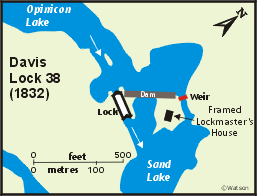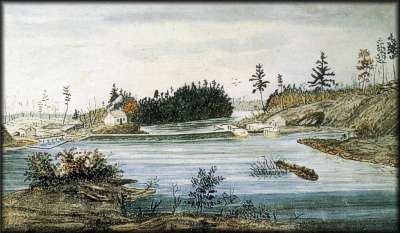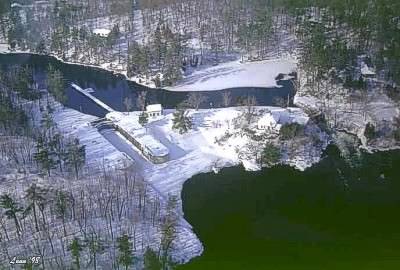Davis Lock 38
| location map | lockstation information |
The Setting
The Davis Rapids were 121 yards (111 m) in length, descending about 5 to 7 feet (1.5 to 2.1 m) over that distance. These rapids were located between Opinicon Lake and Sand Lake. Walter Davis, a loyalist, moved into South Crosby Township in 1800. It was his son, Walter Davis Jr., who in 1818 or 1820 built a sawmill at the rapids between Opinicon and Sand Lakes.
On John Burrows' first survey in May 1827, he noted, "The view of Davies Lake [Sand Lake] is very pleasing. The many islands, as if floating on a transparent mirror which mellowed and reflected by the tint of the morning, strikes the contemplative mind with a sensation of pleasure not easily forgotten."
The Plan
By's original plan, similar to that proposed by Clowes in 1824, was to bypass the existing saw mill at Davis Rapids, placing the lock on the far west bank, in a 30 foot (9.1 m) wide snie (dry flood channel). The channel at this point had already been dammed by Davis and it was proposed to simply reconstruct his existing 270 foot (82 m) long dam as an arched key work stone dam and maintain it as an overflow dam. The lock was proposed to have a lift of 9 feet (2.7 m), and the dam was to be 12 feet (3.7 m) high.
Building the Locks
The original contract was awarded to Donald McLever. He declared bankruptcy by 1829 and left. He was replaced by a partnership of John Haggart and Robert Drummond.
 The initial work here found that the bedrock was extremely hard and difficult to excavate. Malaria also plagued the works; in the summer of 1828 most of the men were sick with "Lake Fever." The initial work here found that the bedrock was extremely hard and difficult to excavate. Malaria also plagued the works; in the summer of 1828 most of the men were sick with "Lake Fever."
By made a number of changes in order to speed up the works and reduce costs. In 1829, he bought the mill and property from Walter Davis Jr. (who was to die of malaria in 1830) for £800. The lock had to be moved slightly downstream "to save cutting through a rise in the ground, which turned out to be Rock instead of Gravel, the removal of which would have been attended with considerable expense."
There wasn't any good quantity and quality of quarry stone near the lock so the required high quality stone for the lock had to be brought in from Halladay's quarry near Elgin, 6 miles (10 km) away. So By abandoned his plan for a stone key work dam and instead substituted a rubble stone dam, consisting of 2 rough stone walls, about 3 feet (0.9 m) apart, with clay puddle rammed between them to make the dam watertight. Earth and stone from the lock excavation was then dumped on top.
Since the dam was no longer to be a stone key work overflow dam, By considered a waste weir to be absolutely necessary, and he decided to put one in at the far eastern end of the dam, at the location of Davis' mill and house. These were torn down to make way for the construction. He also raised the height of the dam to 15 feet (4.6 m) to prevent overflow, ensuring that all the waste water would go through the weir.
The lock was built with a wooden floor, which was faster and cheaper to build than one using inverted masonry arches. By noted, as he had at other locks with wooden floors, that wood, when kept underwater, was considered as durable as stone.
A wood frame house, with an adjacent log house, was built on the knoll - the frame house was used by the contractor and the log house was for the workmen. The frame house was later used as the lockmaster's house prior to the stone lockmaster's house being built in 1842.
 |
Davis' Mill, Lock &c; Looking towards Kingston; Sketched Novy. 1840
Thomas Burrowes, watercolour, Archives of Ontario
This painting shows the view looking towards Sand Lake. Visible are the waste weir (left), the framed lockmaster’s house, the dam and the lock. |
Through the Years
In 1842, the wood frame lockmaster's house was torn down and replaced by a stone defensible lockmaster's house. It had a tin roof, gun slits and thick stone walls. The kitchen was clapboarded in 1890-91 and a small summer kitchen was added in 1898-99. A succession of lockmasters and their families used this house until the retirement of James Pyne in 1959. The house was rented out until a fire in 1983 made it uninhabitable. It was repaired but remained vacant. In 1999 the building was rehabilitated and today it stands as the best preserved example, in terms of original architecture, of a defensible stone lockmaster's house, along the entire Rideau.
In 1843-44 the wooden floor of the lock was repaired as well as some of the sill and breastwork masonry. In 1886-87 parts of the lower wall and lower sill were repaired and in 1888-89 the lower sill was replaced. From 1895-1898 most of the upper part of the lock was reconstructed. In about 1908, both lower wing walls were relaid, the timber floor repaired and the sides of the lock chamber grouted. In 1914-15 the floor was redone in concrete and the upper wing walls redone with stone quarried near Westport.
The lock was completely rebuilt in 1982. The basin was rebuilt with concrete and the old facing stones were split in half and used to reface the newly renovated lock. Some additional new stone had to be imported from Ohio.
The waste weir, originally built with timber, was redone in concrete in the 1930s. The last major reconstruction of the weir was done in 1998.
The wood frame canal station building located beside the lock was built in about 1900.
The wood frame lockstation office located beside the lock was built in 1875. A smaller storage building was built beside the canal station building in 2010.
Over the years dredging fill has been added to the dam, and today it appears to be a natural grassy embankment.
The lock was known for many years as "Foster's Lock" after long serving lockmaster Alfred Forster.
 |
Aerial View of Davis Lock in Winter
Note the waste weir with water pouring through it, on the right side of the photo.
photo by: Simon Lunn, 1998 |
The Lockmasters to 2000
Although Colonel By had recommended a G. Monin (or Morin) for the job, it appears that the first lockmaster was John Purcell. Purcell was lockmaster at Davis until 1857, except for a brief 4 month posting at Brewer's Upper Mills in late 1835 (during which time William Broad served as lockmaster at Davis). He was replaced by John Johnson, a lock labourer from Smiths Falls. Johnson stayed at Davis until 1871 when he exchanged position with Alfred Forster of Newboro. Forster stayed as lockmaster until he was transferred to Jones Falls in 1897 and was replaced by Philander S. Alford of Elgin. Alford died in 1901 and the station was taken over by his son, Elah (Eli) Alford, who served as lockmaster until he retired after nearly 50 years of service in 1947. His replacement was local canalman James Pyne, who remained lockmaster until his retirement in 1959. He was followed by J.S. Moses from 1960 to 1961; Johnny Watters from 1960 to 1972; Roger Gallernault from 1972 to 1981; Bob Martin from 1982 to 1990 and John Watt from 1991 to 2000.
|